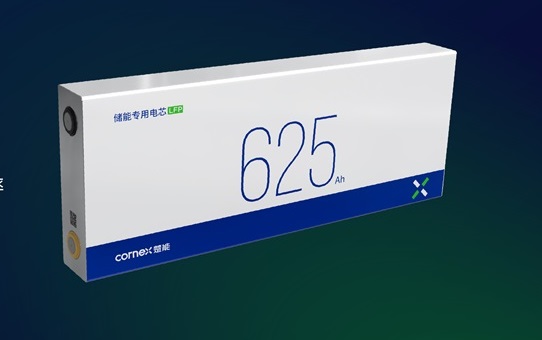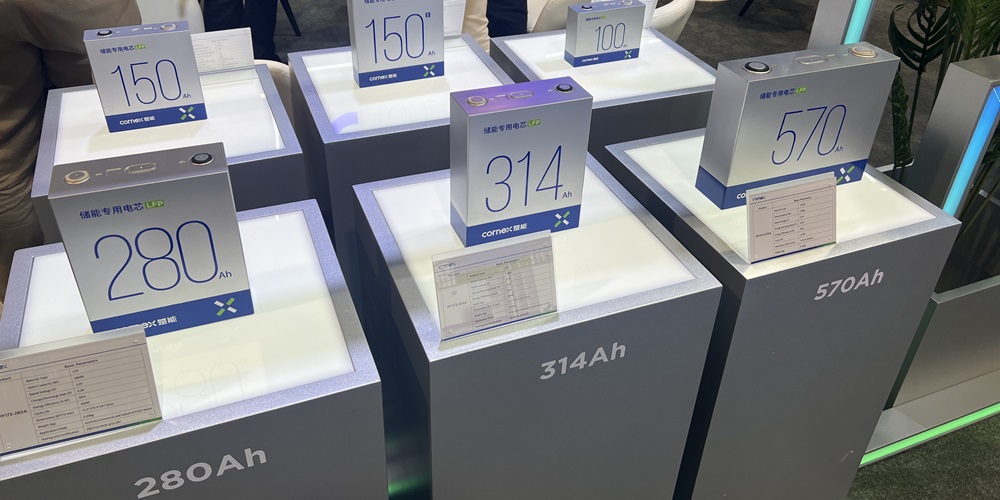We are in the midst of a battery revolution. Multiple layers of intertwined learning curves are converging, driving substantial market changes: falling prices, advancing technology, and scaling capacities. These elements are combining to produce ever greater technological wonders.
A recent exhibition by Cornex at RE+ in Anaheim prominently featured a key aspect of this revolution: prismatic battery cells. Cornex displayed a range of lithium iron phosphate (LFP) battery cells with capacities from 100 Ah to over 700 Ah.
The company’s flagship product, the 314 Ah LFP cell, is integral to its robust, container-sized systems now offered below $100/kWh in China—a price point confirmed by Gotion, a Chinese manufacturer, this September. These systems, featuring the 314 Ah cells, deliver 6.25 MWh of battery storage per 20-foot container. These units are available with a 12-year warranty for 12,000 cycles and an expected retention of at least 72% of its original capacity.

Image: Cornex
Cornex’s 230 Ah EV LFP cells were recently deployed in 50 electric dump trucks, each offering a storage capacity of 282 kWh and a range of up to 260 kilometers.
The company also discussed plans for the next generation of LFP cells and ongoing growth. Currently, Cornex operates three battery cell manufacturing facilities, with capacities of 10 GWh, 35 GWh, and 55 GWh, respectively, totaling 100 GWh of production capacity. By 2028, Cornex aims to more than triple this capacity to 350 GWh, while also increasing its use of factory automation.
While proud of its successful 314 Ah product line, Cornex is also focused on developing next-generation products as part of its expansion. Among these is the 625 Ah battery cell, which Cornex calls the “Two Kilowatt Power” unit.

Launched several months ago, the 625 Ah cell paves the way for 20-foot shipping containers to exceed 6.5 MWh of capacity. Envision Energy has recently launched an 8 MWh shipping container storage product using a 700 Ah battery cell, marking a significant jump from its earlier 315 Ah cells.
Cornex has also indicated it is considering additional future technologies, including sodium batteries for vehicles, potentially building electric vehicles themselves, and expanding both in China and elsewhere.
This content is protected by copyright and may not be reused. If you want to cooperate with us and would like to reuse some of our content, please contact: editors@pv-magazine.com.








Hi John, What does “…deliver 6.25 MWh of battery storage per 20-foot container.” mean? Specifically what does 20-foot refer to? Are the battery packs 20-foot long? Thanks
The standard physical format of utility scale batteries is the 20 ft shipping container. The industry has adopted it because humanity is amazing at moving shipping container sized things.
Check out the image at the top of this article – https://pv-magazine-usa.com/2024/10/11/californian-city-introduces-temporary-moratorium-on-battery-storage-sites/
It shows a battery farm, with long skinny shipping containers next to small boxes – transformers. Within the shipping containers sized objects are a collection of electrical cabinets that hold battery management systems, lots of wiring, communications, fire suppression, hvac, etc – and of course battery packs that contain battery cells. The battery cells are the focus of this article. The total 6.5 MWh of capacity held within them when fully charged.
Images here show a battery cabinet open, plus some solar, and the cabinets closed from afar – one of Commercial Solar Guy’s projects in NY:
https://www.linkedin.com/posts/commercialsolarguy_solar-energystorage-constructing-activity-7170482269072076800-BgNw
The USA (and ALL Other Nations) need just Hydro Energy Storage to peovide S2S … Sunset To-Sunrise… Energy Storage to support a Pollution Free Solar/PV System to provide 24hr/day Pollution Free Electricity… No Toxin of other Polluting Waste (from Dead Batteries) here..
This can readily be achieved by using UHES (see youtube channel zeropollution2050… UHES) by using PHS.. Pumped Hydro Storage at the EXISTING SITES & sharing the existing Hydro Storage too…
Thanks for good articles!
Curious to learn more about the US alternatives for batteries. Rec Silcon, Sila, One D, G14
Will they have a chance against China ?
Dang, just when I think I have my arms around the current state of affairs and near future, news comes along that forces me to etch-a-sketch all that and set my mental bar higher.